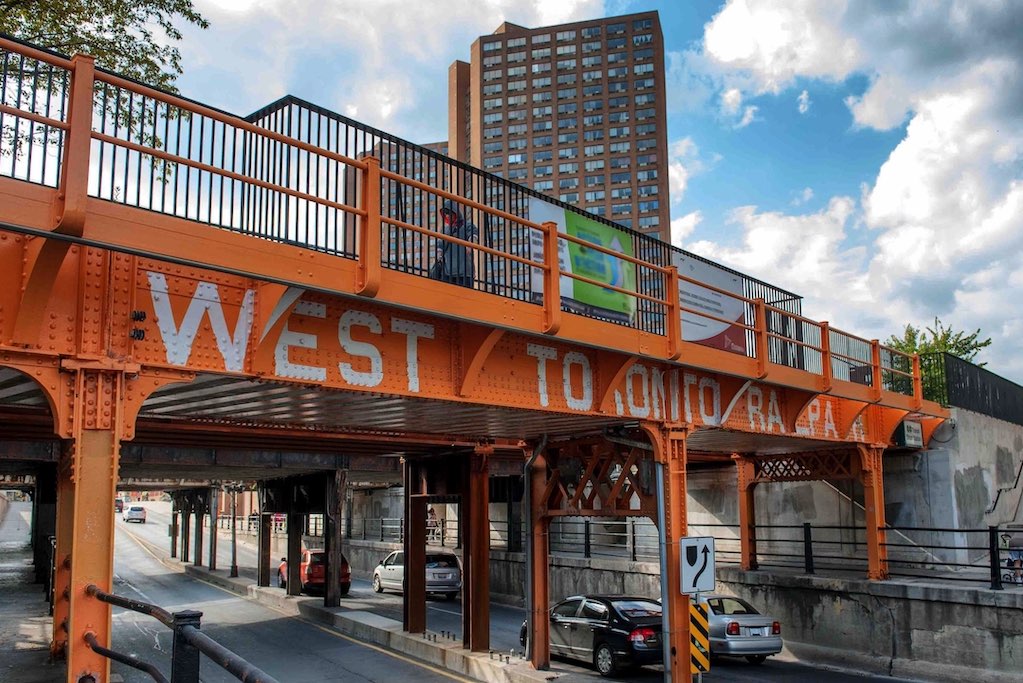Infra
Ontario Government Move to Limit Bike Lanes Sparks Outrage in Toronto

In a move that has raised serious concerns among urban planners, road safety advocates, Toronto residents, 120 physicians and researchers from the University of Toronto, a local business association, and, well, a lot of other people, the Ontario government has added an amendment to Bill 212 that could have sweeping implications for the city’s cycling infrastructure. Under this legislation, municipalities would need provincial approval to create new bike lanes where a traffic lane is removed. And this is not just in Toronto, it is across the province.
This is an unprecedented intrusion on Ontario municipalities ability to govern its own streets. The bill not only sees the province sticking its conservative, car-loving noses in city business it also stipulates the removal of existing bike lanes on key Toronto arteries: University Avenue, Yonge Street, and Bloor Street.
It’s a proposal former Vancouver chief planner Brent Toderian called “Wrong-headed,” in an article in the Toronto Star, going on to say it “is like instituting a ban on intelligence.”
Thinking bike lanes cause traffic is like thinking the sun goes around the earth: based off personal observation, it’s plausible.
“The sun rises in the east, sets in the west… and is very small.”
But it’s not true! And looking for evidence proves it!
— Sir Tainley (@Tainley_Sir) November 1, 2024
A Question of Overreach and Safety
Bill 212, which mandates a public comment period until Nov. 20, is being criticized as an overreach into local governance. Municipal leaders argue that the province’s move undermines city jurisdiction over urban planning and jeopardizes Toronto’s progressive strides toward safer, sustainable mobility. The Association of Municipalities of Ontario (AMO) voiced strong opposition:
“Bicycle lanes are an essential element of urban transportation planning and road safety. Requiring provincial approval would be a significant overreach into municipal jurisdiction,” AMO stated. “Based on local knowledge and community input, municipalities develop transportation plans that balance traffic flow with priorities like active transportation, multimodal transit, and environmental and health protection. AMO is not aware of any consultation with municipalities regarding bicycle lanes or of the evidence the province considered in its decision.”
Prioritize Safety Over Travel Times
The proposal has prompted a backlash from a coalition of 120 healthcare professionals and researchers at the University of Toronto, who argue, in a letter to the provincial government, that prioritizing road safety over traffic flow is paramount. They emphasize that traffic-related injuries and deaths are often preventable through better infrastructure design. In 2022 alone, Canada witnessed 294 pedestrian deaths, 46 cyclist deaths, and over 8,800 serious injuries due to collisions. The group points out that protective measures like bike lanes reduce the risk of trauma and benefit all road users.
Research supports that protected bike lanes lead to fewer injuries and deaths, with public health data highlighting high-risk areas that could benefit from such interventions. The physicians’ letter calls for the Ontario government to rethink its priorities, emphasizing that complete streets and reduced vehicle speeds save lives and prevent life-altering injuries. Notably, beyond the victims themselves, traffic incidents create ripple effects impacting families, caregivers, and even the drivers involved.
The signatories to the letter underline that Ontario’s Ministry of Transportation should focus on serving people, not just vehicles. Addressing root causes of traffic congestion through improved public transit and encouraging non-vehicular travel is essential for fostering safe and inclusive roadways.
West Toronto Railpath cycling route in Toronto, Ontario
Local Impact and Voices of Concern
For residents like Madeleine Bonsma-Fisher, a cyclist and parent, the threat to current and future bike lanes is personal. “If this policy is passed, it will become harder and more dangerous to ride a bike. The city won’t be able to move forward on their sustainable mobility plans. I bike to work almost every day using the Danforth and Bloor bike lanes,” she said. “Before those bike lanes existed, I would never have dreamed I would be making that trip regularly. But most importantly, this policy is a threat to the safety of Ontarians — without safe bike infrastructure, more people will be hurt and killed by cars.”
Bonsma-Fisher summed up her frustration by pointing out that “Doug Ford’s plan to ban future bike lanes and remove some existing lanes is a waste of taxpayer money. It will not reduce congestion; it will do the opposite by taking away a safe and efficient alternative to driving.”
Evidence in Favor of Bike Lanes
Contrary to some claims that bike lanes exacerbate traffic congestion, Toronto Fire Services has observed improvements in emergency response times along bike lane corridors, a critical safety factor often overlooked. Additionally, business groups like the Bloor Annex BIA have reported economic benefits tied to bike lanes, underscoring the argument that safe cycling infrastructure supports, rather than hinders, local commerce.
“Are we building highways or are we building main streets?” questioned Brian Burchell, general manager of the Bloor Annex BIA. “Because highways don’t encourage main street economic activity.”
And, there is a sizeable amount of evidence that separated bike lanes that encourage cycling for transportation actually ease congestion. It doesn’t happen overnight because people need a complete and safe bicycle network, but it is already happening in Toronto.
Toronto Bike Share is growing by leaps and bounds and has seen millions of trips in 2024, more than 760,000 just in June. Without safe cycling infrastructure that number could plateau and then drop.
One simply needs to look at global cities such as Paris and Copenhagen to see what is possible with investment in people and sustainable transportation. Or, for the road route see Los Angeles and other cities. Anyone smarter than a bag of hammers can see that the population is increasing, housing is sprawling and Toronto is not building any more roads inside its borders. Bike lanes, public transit and other alternatives are the options. Period.
Now that an ill-informed, suburban cabal of SUV lovers is dictating transportation policy for Canada’s largest city even though most of them don’t live in Toronto or, frankly, care about the well-being of its residents, the network will have holes, fewer people will cycle, traffic congestion will get worse and people will get hurt and killed. It will be Premier Doug Ford’s fault.
In short, the Ontario government is turning bike lanes into a culture war to solicit votes from far-flung locations outside the city of Toronto.

Once temporary now permanent Yonge Street bike lane in Toronto
Political and Public Backlash
Toronto Mayor Olivia Chow has been a critic of the Ontario legislation, emphasizing the detrimental effects it could have on public safety and traffic flow.
“Ripping up our roads like this will make people less safe, make traffic worse, and put lives at risk. Full stop. I challenge the Premier to talk to people who have lost loved ones on our roads and hear their stories,” Chow said. She also pointed to the province’s delays in transit project completions as a significant contributor to congestion. “Stay in your lane, open the Eglinton Crosstown and Finch West LRT, and fix the chaos at Metrolinx,” she added.
But, beyond a well-worded statement, there is little evidence the city will stand in Ford’s way.
So, it is up to cycling advocates, who have already started rallies and protests under the banner “Leave our lanes alone!”
The Broader Context
Critics argue that while Doug Ford’s policies may resonate with suburban Ontario voters, they ignore the proven benefits of urban cycling infrastructure. Studies repeatedly show that bike lanes reduce traffic congestion by providing a reliable alternative to driving, effectively putting fewer cars on the road. In addition, cycling infrastructure contributes to public health and reduces carbon emissions, aligning with broader sustainability goals.
“If this policy passes, it’s not just bike lanes that will be at risk,” Bonsma-Fisher said. “It’s community safety, efficient commutes, and the potential for a city that prioritizes its people over cars.”
With public comments open, Toronto residents and advocacy groups are mobilizing to ensure their voices are heard.









